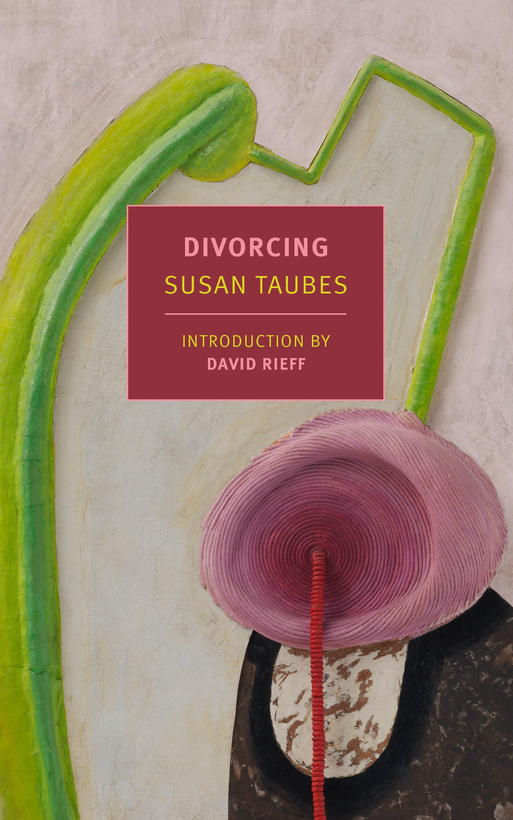In Sylvia Plath’s famous poem “Lady Lazarus,” written shortly before the poet’s death in 1962, a dead woman returns from the grave. She displays her resurrected body like the object it almost became, seeming to derive a sly satisfaction. “Dying / Is an art, like everything else,” she says. “I do it exceptionally well.”
The 1969 novel Divorcing, by Susan Taubes, reissued this month by New York Review Books, unsettles with the same gruesome craft. Taubes’s close friend, the writer Susan Sontag, is said to have considered the book a “rehearsal” for its author’s self-destruction; sure enough, Taubes died by suicide a week after Divorcing was published.
Hers is one of two deaths that hang over the novel, the other being the decapitation of its protagonist, Sophie Blind, who is struck by a car while crossing the street on page 10. Or maybe Sophie dies on page 57, in a plane crash en route to New York from Paris. Or maybe she doesn’t die at all, but only dreams of doing so, a distinction without a difference in a novel where nightmares exert as much pull as reality. It’s not only the reader but also Sophie herself who can’t quite determine whether she remains among the living. She has long felt that “the world in which she would have wanted to live had ended,” leaving her irretrievably lost in space and time. “Her sense of the matter was that things were generally hopeless and that there was no place for her anywhere.”
A Separation
Divorcing is nominally the story of a woman’s effort to pry her freedom from the grasp of a selfish, bullying husband. (Sophie, an aspiring writer married to a prominent Jewish intellectual who travels the world on various academic appointments, closely resembles her creator, who married and then divorced the celebrated philosopher of religion Jacob Taubes.) But the more consequential separation is the one that Sophie keeps enacting against herself, pushing off from her past like a woman fleeing a sinking ship in a lifeboat. She sealed away her Hungarian childhood after she escaped Budapest as a refugee in 1939, and disowned her secular American girlhood when she married her devout, cosmopolitan husband. These outlines of a life emerge slowly from the kaleidoscope of Sophie’s consciousness, where anger is metabolized in dreamlike visions: a funeral conducted like a wedding, complete with a chance to object at the end; a wedding that climaxes in the ritual rape and murder of the bride.
The novel’s strongest passages don’t ask why Sophie can’t knit her life together—or whether she remains physically intact—but simply transmit her unhappiness like an electric charge. A scene in which she fights with her husband burns with bitter humor: “He boohoos shamelessly like a child, the tears drop on his shoe.” A return visit to Budapest aches with her perpetual sense of unreality: “She walked through ten days guardedly, as in a dream where it is useless to pick up gold coins scattered over the street because you wake up in a room in another country without those lovely coins, feeling terribly deceived.”
Susan Taubes’s is one of two deaths that hang over the novel, the other being that of its protagonist.
Sophie hopes that the solution to her suffering is to write a book. “Books were better than dreams or life,” she reflects; whereas she struggles to tell the other two apart, “in a book she knew where she was.” Later sections of the novel double as the beginnings of Sophie’s book about her childhood in a lost Budapest. These memories are often disturbing and fascinating, especially when they revolve around Sophie’s mother, a dramatic, mercurial woman who shifts between affection and accusation so suddenly that she provokes an early experience of dislocation: Sophie sees “the child in the room as someone else, an undefined mass, an empty outline.”
Splayed before the reader in no particular narrative order, these snapshots seem at times to invite us to search for a story to explain the protagonist. Sophie’s father, a Freudian analyst like Taubes’s own, hovers in the background attempting to do exactly that, though his efforts never seem to come close to the mark. (Predictably, he diagnoses his daughter with an Electra Complex). The recollections drag, and then end abruptly, as if Taubes can’t decide whether they reveal anything of import or not.
Sontag famously argued that art should be encountered as “an experience, not a statement or an answer to a question.” This prescription applies to Divorcing, which seems torn between the hope that a book can be a remedy, and the suspicion that there’s no point in the story it tells. Even the sections that relate specifically female forms of immiseration—the way Sophie is “used up” by marriage and motherhood—seem indifferent to any political implications. It’s easy to imagine a world in which Taubes’ work, like Plath’s, was taken up by second-wave feminists as an urgent expression of the problems around which they organized. But in Divorcing, a book is not better than life because it clarifies life’s suffering, or presents a cure for it, but because, in a book, even the ghastliest fantasy can be exploited for its beauty without doing anyone harm.
Nora Caplan-Bricker is a writer living in Boston
